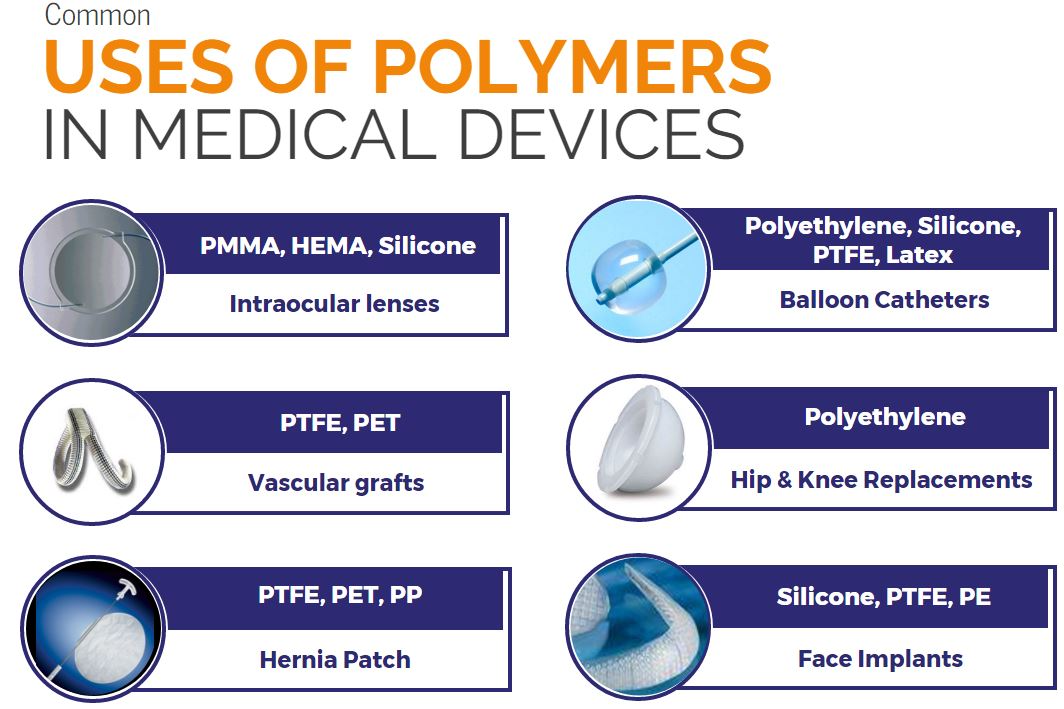The selection of a polymer for a medical device requires careful thought and knowledge of both the plastic and the target application, and how each will respond to the other. The range of choices of polymers for medical applications continue to increase as resin manufacturers synthesize novel homopolymers and copolymers, compounders create polymer blends and additives packages, and processors perform finishing steps such as crosslinking and surface treatments. Polymeric materials in medical devices range from rigid UHMWPE and PEEK, to flexible TPEs, films, and woven constructs, to soft hydrogels.
What is the Target Application of Your Medical Device?
When we assist clients in selecting a polymer for their device, the project always starts with a detailed description of the target application. Will the device be an implant with longer than 30 days in the body, will it be in the body for less than 30 days, or will it never contact the patient directly but instead be used in a medical setting (such as packaging or the housing on an infusion pump)? If the device is an implant, is it intended to be permanent or is deliberate degradation desirable? If the latter, over what time scale? And of course, where in the body will the device be used?
Following these questions, we then ask about the device design to get a sense of what material properties will be important. For example, in a hip or knee component wear behavior is important, along with resistance to fracture due to impact loads. For a spinal rod, creep behavior under physiological loads is relevant. For a heart valve, fatigue resistance for millions of cycles is relevant. For a drug release device, the microstructure of the material is important as it can influence the release kinetics. If known, target material properties, such as tensile strength, modulus in the relevant loading condition, wear rates, or pore size, are listed as required specifications. This information is often the result of computer simulation of the design in its target application area. Often times, however, the required specifications or material behavior inputs for simulation are not known, and some initial guesses have to be made, to be verified later during screening tests.
As part of this discussion, the potential manufacturing process is considered, which will further aid in polymer identification. In some designs, injection molding is required, while others may require film extrusion, compression molding or fiber spinning. The use of additive manufacturing has further expanded the consideration of material selection. Storage life of the plastic is relevant for inventory control, as is secondary sources of the material. Lastly, the cleaning and disinfection/sterilization process has to be considered, since both can affect some polymer materials.
This approach helps define the required material specifications for the device. This list may grow as more information is gathered through screening tests, design verification tests, or even through validation testing.
Material Selection & Testing
We then begin assembling a list of candidate materials, normally starting with materials that meet the known property requirements. This material list can be filtered by materials that already have clinical use, ideally in the same or similar clinical area. Any clinically relevant information, such as testing performed to ISO 10993, is considered. There are many cases where an off-the-shelf solution does not exist, but a custom formulation or modification of an off-the-shelf solution can be provided.
After the list of candidate materials has been reviewed with the client, selected candidate materials will be ordered. At this point, we will often perform specific tests on the materials relevant to the client’s target application that are beyond the standard mechanical property tests provided by the resin manufacturer. These tests may include standard or custom fatigue tests, oxidation resistance tests, biocompatibility tests including leaching and extractables, or processability tests. Based on results of these tests, the list of candidate materials can be further reduced.
From this reduced list, we or the client will then make prototype assemblies of the target device, in order to test manufacturing processes and to evaluate the potential failure modes of the device with the candidate materials. Based on these results, the material criteria may be further modified, the design may be adjusted, or a candidate material may rise to the top.
Of course, the cost of the polymer is an important consideration. Depending on the anticipated volume and price point of the device, pricing considerations may be a primary criterion, or a secondary one. The actual polymer pricing depends heavily on volume and form factors.
During this whole process, we encourage the client’s production team to be involved, along with the design team, as both parties have unique understanding of their capabilities and requirements.
If you need assistance in developing a new medical device, or in evaluating alternate materials for an existing device, please contact us.


